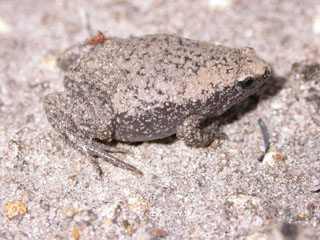Microhylidae
Microhylidae is a family of frogs. There are 495 species in 68 genera and nine subfamilies. This is the largest number of genera of any frog family.[1]
| Microhylidae Temporal range: early Miocene to Recent
24–0 mya | |
|---|---|

| |
| Eastern narrowmouth toad (Gastrophryne) | |
| Scientific classification | |
| Kingdom: | |
| Phylum: | |
| Class: | |
| Order: | |
| Suborder: | |
| Family: | Microhylidae Günther, 1858
|

| |
| Distribution of Microhylidae (in black) | |
Description
changeMicrohylids are mostly small frogs. Many species have bodies shorter than 1.5 centimetres (0.59 in) in length from nose to rear end. The largest microhylids are 9 centimetres (3.5 in).[2] They can live in trees or on land. Some will even live close to water. The ground dwellers are often found under leaf litter within forests. The sometimes go out at night to hunt. There are two main shapes for the microhylids. One shape is with wide bodies and narrow mouths. The other shape is the normal frog shape. Those with narrow mouths eat termites and ants, and the others eat the same foods as other frogs.
Reproduction
changeThe microhylids that live in New Guinea and Australia do not have a tadpole stage. Those who live in trees can lay the eggs in trees, and do not ever need to go to the ground. Where species do have tadpoles, these almost always do not have the teeth or horny beak like other tadpoles do.[2]
Taxonomy
change- subfamily Adelastinae Peloso, Frost, Richards, Rodrigues, Donnellan, Matsui, Raxworthy, Biju, Lemmon, Lemmon, & Wheeler, 2015
- genus Adelastes Zweifel, 1986
- subfamily Asterophryinae Günther, 1858
- genus Aphantophryne Fry, 1917
- genus Asterophrys Tschudi, 1838
- genus Austrochaperina Fry, 1912
- genus Barygenys Parker, 1936
- genus Callulops Boulenger, 1888
- genus Choerophryne Van Kampen, 1914
- genus Cophixalus Boettger, 1892
- genus Copiula Méhely, 1901
- genus Gastrophrynoides Noble, 1926
- genus Hylophorbus Macleay, 1878
- genus Mantophryne Boulenger, 1897
- genus Oninia Günther, Stelbrink & von Rintelen, 2010
- genus Oreophryne Boettger, 1895
- genus Paedophryne Kraus, 2010
- genus Siamophryne Suwannapoom, Sumontha, Tunprasert, Ruangsuwan, Pawangkhanant, Korost, and Poyarkov, 2018
- genus Sphenophryne Peters & Doria, 1878
- genus Vietnamophryne Poyarkov, Suwannapoom, Pawangkhanant, Aksornneam, Duong, Korost and Che, 2018
- genus Xenorhina Peters, 1863
- subfamily Chaperininae Peloso, Frost, Richards, Rodrigues, Donnellan, Matsui, Raxworthy, Biju, Lemmon, Lemmon, & Wheeler, 2015
- genus Chaperina Mocquard, 1892
- subfamily Cophylinae Cope, 1889
- genus Anilany Scherz, Vences, Rakotoarison, Andreone, Köhler, Glaw, and Crottini, 2016
- genus Anodonthyla Müller, 1892
- genus Cophyla Boettger, 1880
- genus Madecassophryne Guibé, 1974
- genus Mini Scherz, Hutter, Rakotoarison, Riemann, Rödel, Ndriantsoa, Glos, Roberts, Crottini, Vences & Glaw, 2019
- genus Plethodontohyla Boulenger, 1882
- genus Rhombophryne Boettger, 1880
- genus Stumpffia Botteger, 1881
- subfamily Dyscophinae Boulenger, 1882
- genus Dyscophus Grandidier, 1872
- subfamily Gastrophryninae Fitzinger, 1843
- genus Arcovomer Carvalho, 1954
- genus Chiasmocleis Méhely, 1904
- genus Ctenophryne Mocquard, 1904
- genus Dasypops Miranda-Ribeiro, 1924
- genus Dermatonotus Méhely, 1904
- genus Elachistocleis Parker, 1927
- genus Gastrophryne Fitzinger, 1843
- genus Hamptophryne Carvalho, 1954
- genus Hypopachus Keferstein, 1867
- genus Myersiella Carvalho, 1954
- genus Stereocyclops Cope, 1870
- subfamily Hoplophryninae Noble, 1931
- genus Hoplophryne Barbour & Loveridge, 1928
- genus Parhoplophryne Barbour & Loveridge, 1928
- subfamily Kalophryninae Mivart, 1869
- genus Kalophrynus Tschudi, 1838
- subfamily Melanobatrachinae Noble, 1931
- genus Melanobatrachus Beddome, 1878
- subfamily Microhylinae Günther, 1858
- genus Glyphoglossus Gunther, 1869 "1868"
- genus Kaloula Gray, 1831
- genus Metaphrynella Parker, 1934
- genus Microhyla Tschudi, 1838
- genus Micryletta Dubois, 1987
- genus Mysticellus Sonali & Biju, 2019
- genus Nanohyla Gorin, Scherz, Korost & Poyarkov, 2021[3]
- genus Phrynella Boulenger, 1887
- genus Uperodon Duméril & Bibron, 1841
- subfamily Otophryninae Wassersug & Pyburn, 1987
- genus Otophryne Boulenger, 1900
- genus Synapturanus Carvalho, 1954
- subfamily Phrynomerinae Noble, 1931
- genus Phrynomantis Peters, 1867
- subfamily Scaphiophryninae Laurent, 1946
- genus Paradoxophyla Blommers-Schlösser & Blanc, 1991
- genus Scaphiophryne Boulenger, 1882
Range
changeFrogs from Microhylidae live throughout the tropical and warm temperate regions of North America, South America, Africa, eastern India, Sri Lanka, south-east Asia, through New Guinea and Australia. Although most are found in tropical or sub-tropical regions, a few species can be found in arid or non-tropical areas. They are the majority frog species in New Guinea and Madagascar.
References
change- ↑ Blackburn D.C. & Wake D.B. (2011). "Class Amphibia (Gray, 1825). In: Zhang Z.-Q. (ed) Animal biodiversity: An outline of higher-level classification and survey of taxonomic richness" (PDF). Zootaxa. 3148: 39–55. doi:10.11646/zootaxa.3148.1.8.
- ↑ 2.0 2.1 Cogger H.G. & Zweifel R.G., ed. (1998). Encyclopedia of reptiles and amphibians. San Diego: Academic Press. pp. 102–103. ISBN 0-12-178560-2.
- ↑ Gorin, Vladislav A.; Scherz, Mark D.; Korost, Dmitriy V.; Poyarkov, Nikolay A. (2021-12-01). "Consequences of parallel miniaturisation in Microhylinae (Anura, Microhylidae), with the description of a new genus of diminutive South East Asian frogs". Zoosystematics and Evolution. 97 (1): 21–54. doi:10.3897/zse.97.57968. ISSN 1860-0743.
- Zug, George R.; Laurie J. Vitt and J.P. Caldwell (2001). Herpetology: an introductory biology of amphibians and reptiles 2nd Edition. Academic Press. ISBN 0-12-782622-X.